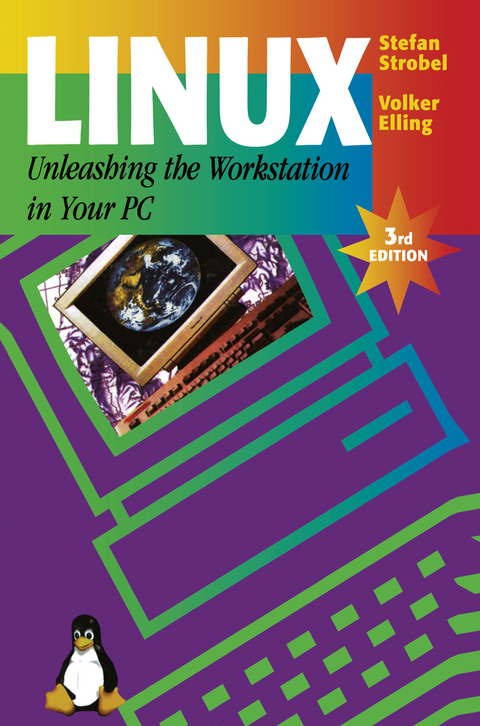
Linux - Unleashing the Workstation in Your PC
Springer-Verlag New York Inc.
978-0-387-94880-5 (ISBN)
NIX achieved its widespread propagation, its penetration of UNIX history U the university domain, and its reach into research and industry due to its early dissemination by AT&T to all interested parties at almost no cost and as source code. UNIX's present functionality emanated not just from AT&T developers but also from many external developers who used the product and contributed their own further developments, which they then put at AT&T's disposal. (Consider the contributions of the University of California at Berkeley, for example.) With the rising commercialization of UNIX by AT&T (and the current owner, Novell) since 1983, and with the philosophical wars between the large UNIX vendors such as Sun, HP, Digital, IBM, SCQ, and the UNIX laboratory, as well the more rhetorical than factual discussions between QSF and UNIX International, such creative and cooperative continuing development became increasingly restricted, and UNIX source code today has become unaffordably expensive and de facto inaccessible. Linux has changed the situation. Linux provides interested computer scientists and users with a system that revives the old UNIX tradition: Linux is available for free, and everyone is heartily free & participatory invited (but not obliged) to contribute to its continuing development. When I wrote the foreword to the first edition of this book in 1994, Linux, because it ran on PC systems, had begun to penetrate the workrooms of many computer science students and computer freaks.
1.1 Historical perspectives on Linux.- 1.2 Versions.- 1.3 Features.- 1.4 UNIX development and standards.- 1.5 The Free Software Foundation.- 1.6 An overview of Linux features.- Basics.- 2.1 Multi-user operation.- 2.2 Multitasking.- 2.3 Memory management.- 2.4 Shell model.- 2.5 File systems.- 2.6 Devices.- 2.7 Shells.- 2.8 Search patterns.- 2.9 Daemons.- 2.10 Overview of commands.- Linux features.- 3.1 Virtual consoles.- 3.2 Linux file systems.- 3.3 Data exchange.- 3.4 Loadable Modules.- 3.5 Sound.- 3.6 Extended commands.- 3.7 New features in Linux 2.0.- 3.8 The pros and cons of upgrading.- Emulators.- 4.1 DOS emulator.- 4.2 WINE.- 4.3 iBCS2 emulator.- 4.4 HP48 emulator (X48).- 4.5 IBM 3270 emulator.- 4.6 Macintosh emulator.- Installation.- 5.1 Linux distributions.- 5.2 Sources.- 5.3 Hardware.- 5.4 Installation.- 5.5 Boot manager.- Configuration.- 6.1 General configuration 1l.- 6.2 Kernel.- 6.3 Daemons.- 6.4 Serial login.- 6.5 Fax.- 6.6 Metadevices and RAID.- 6.7 Streamers and CD-ROM drives.- Administration.- 7.1 The administrator.- 7.2 Booting.- 7.3 Shutdown.- 7.4 The Linux directory tree.- 7.5 Users and groups.- 7.6 Shells.- 7.7 User information.- 7.8 Backups.- 7.9 File system management.- 7.10 Upgrades.- 7.11 Installation of software packages.- 7.12 Creating boot diskettes.- X Window System.- 8.1 Features.- 8.2 Structure.- 8.3 X resources.- 8.4 Window managers.- 8.5 Toolkits.- 8.6 X11 server.- 8.7 Linux as X terminal.- 8.8 X11 configuration.- 8.9 Configuration of X applications.- Networking.- 9.1 Network hardware.- 9.2 TCP/IP.- 9.3 IP.- 9.4 IP aliasing.- 9.5 Serial connections.- 9.6 PPP.- 9.7 Parallel connection.- 9.8 ISDN.- 9.9 TCP and UDP.- 9.10 Host names.- 9.11 UUCP.- 9.12 RPC.- 9.13 NIS.- 9.14 NFS.- 9.15 LAN manager.- 9.16 PC/NFS.- 9.17 ISODE.- 9.18 Novell Netware.- Network applications.- 10.1 Network daemons.- 10.2 Internet daemon (inetd).- 10.3 Telnet.- 10.4 Secure shell.- 10.5 FTP.- 10.6 Archie.- 10.7 Berkeley r-utilities.- 10.8 Mail.- 10.9 News.- 10.10 IRC.- 10.11 Gopher.- 10.12 World Wide Web.- 10.13 Network management.- Support and help.- 11.1 man, xman.- 11.2 Info.- 11.3 Newsgroups.- 11.4 FAQs and HOWTOs.- 11.5 WWW.- 11.6 Mailing lists.- 11.7 Other documents.- 11.8 Other sources.- Applications.- 12.1 Desktop environment.- 12.2 StarOffice.- 12.3 Editors.- 12.4 Graphic programs.- 12.5 Word processing.- 12.6 Multimedia environment Andrew.- 12.7 Databases.- 12.8 Java.- 12.9 Mathematical applications.- 12.10 Simulations.- 12.11 Games and recreation.- GNU Emacs.- 13.1 Overview.- 13.2 Basic terms.- 13.3 Operation.- 13.4 Documentation and help.- 13.5 Modes.- 13.6 Packages and enhancements.- 13.7 Emacs Lisp.- 13.8 Configuration.- Languages and tools.- 14.1 Languages.- 14.2 C compilers.- 14.3 Pascal, Fortran, Simula, and Modula-2.- 14.4 Lisp and Prolog.- 14.5 Ada.- 14.6 Tel.- 14.7 Interface builders.- 14.8 Metacard.- 14.9 awk, gawk.- 14.10 Perl.- 14.11 Editors.- 14.12 GNU Debugger (GDB).- 14.13 Make utility.- 14.14 Imake.- 14.15 RCS.- 14.16 xwpe.- 14.17 Example.- Linux and security.- 15.1 Cryptology.- 15.2 UNIX system security.- 15.3 Information sources.- Linux command reference.- 16.1 X-Windows.- 16.2 System and processes.- 16.3 User and group management.- 16.4 File and directory management.- 16.5 Terminal.- 16.6 Viewers and editors.- 16.7 Archiving and compression.- 16.8 Disk management and file systems.- 16.9 On-Line Manual.- 16.10 Development and installation.- 16.11 File processing.- 16.12 Text formatting.- 16.13 Time.- 16.14 Internet and communication.- 16.15 Shells and shell tools.- 16.16 Printing.- 16.17 Miscellaneous.- Error and error localization under Linux.- 17.1 Where to find error messages.- 17.2 Some errors and their possible causes.- 17.3 Frequent error messages and possible causes.- 18.1 Contents of the proc file system.- 18.2 Overview of /etc files.- 18.3 Overview of /etc directories.- 18.4 Hidden files in home directories.- 18.5 List of known SunSite mirrors.
"Strobel and Uhl...bring together in a single, coherent volume the knowledge that a new user needs to acquire Linux, install it on a computer, and become acquainted with the wide range of applications that are either included with most Linux distributions or available (usually free) over the Internet." Computing Reviews
| Erscheint lt. Verlag | 6.5.1997 |
|---|---|
| Übersetzer | R. Bach, A. Derieg |
| Vorwort | J. Gulbins |
| Zusatzinfo | XV, 608 p. |
| Verlagsort | New York, NY |
| Sprache | englisch |
| Maße | 155 x 235 mm |
| Themenwelt | Informatik ► Betriebssysteme / Server ► Unix / Linux |
| Mathematik / Informatik ► Informatik ► Netzwerke | |
| Mathematik / Informatik ► Informatik ► Web / Internet | |
| ISBN-10 | 0-387-94880-5 / 0387948805 |
| ISBN-13 | 978-0-387-94880-5 / 9780387948805 |
| Zustand | Neuware |
| Haben Sie eine Frage zum Produkt? |
aus dem Bereich


